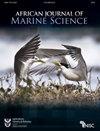Prevalence, population structure and burrow morphology of the kelp-boring amphipod Sunamphitoe roberta
IF 1.4
4区 生物学
Q3 MARINE & FRESHWATER BIOLOGY
引用次数: 0
Abstract
The recently described amphipod Sunamphitoe roberta lives only on the kelp Ecklonia maxima, where it excavates slit-like burrows along the distal margins of thicker primary fronds. Oval chambers along the bases of these slits may represent feeding areas. As burrowing proceeds, the damage progressively erodes back the frond margins, giving them characteristic attenuated and irregular profiles, and probably impacting secondary frond survival and growth, and hence kelp productivity. A kelp forest in False Bay, South Africa, was surveyed to determine what proportion of kelp was infected as well as which individuals were selected as hosts. Forty kelp heads were also dissected to ascertain numbers of amphipods per host and their size composition, and to document details of burrow structure. Of 305 adult kelps inspected, 117 (38.4%) showed visible amphipod damage. Rate of infestation was not correlated with stipe length but was positively correlated with head circumference and negatively correlated with the proportion of secondary fronds remaining. The 40 kelp heads dissected contained 786 S. roberta specimens. These comprised 154 adults (>8 mm), including 33 ovigerous females, and 632 juveniles (<8 mm). The number of amphipods per host ranged from 1 to 112 (mean 19.7 [SD 25.1]). Size distribution was bimodal, and the largest individual measured 20 mm.食海带片足类的流行、种群结构和穴道形态
最近描述的两栖纲Sunampithoe roberta只生活在大型海带Ecklonia maxima上,它在较厚的初级叶的远端边缘挖掘出狭缝状的洞穴。沿着这些狭缝底部的椭圆形腔室可能代表进食区域。随着挖洞的进行,破坏逐渐侵蚀回叶缘,使其具有衰减和不规则的特征,并可能影响次生叶的生存和生长,从而影响海带的生产力。对南非福尔斯湾的一片海带林进行了调查,以确定有多大比例的海带被感染,以及哪些个体被选为宿主。还解剖了40个海带头部,以确定每个宿主的片脚类数量及其大小组成,并记录洞穴结构的细节。在检查的305只成年海带中,117只(38.4%)显示出明显的两栖类损伤。侵扰率与菌柄长度无关,但与头围呈正相关,与次生叶的剩余比例呈负相关。解剖的40个海带头部包含786个S.roberta标本。其中包括154只成虫(>8毫米),包括33只产卵雌性和632只幼体(<8毫米)。每个宿主的片脚类数量从1到112个不等(平均19.7[SD 25.1])。大小分布呈双峰分布,最大个体的尺寸为20毫米。
本文章由计算机程序翻译,如有差异,请以英文原文为准。
求助全文
约1分钟内获得全文
求助全文
来源期刊

African Journal of Marine Science
生物-海洋与淡水生物学
CiteScore
2.60
自引率
16.70%
发文量
17
审稿时长
6-12 weeks
期刊介绍:
The African (formerly South African) Journal of Marine Science provides an international forum for the publication of original scientific contributions or critical reviews, involving oceanic, shelf or estuarine waters, inclusive of oceanography, studies of organisms and their habitats, and aquaculture. Papers on the conservation and management of living resources, relevant social science and governance, or new techniques, are all welcomed, as are those that integrate different disciplines. Priority will be given to rigorous, question-driven research, rather than descriptive research. Contributions from African waters, including the Southern Ocean, are particularly encouraged, although not to the exclusion of those from elsewhere that have relevance to the African context. Submissions may take the form of a paper or a short communication. The journal aims to achieve a balanced representation of subject areas but also publishes proceedings of symposia in dedicated issues, as well as guest-edited suites on thematic topics in regular issues.
 求助内容:
求助内容: 应助结果提醒方式:
应助结果提醒方式:


